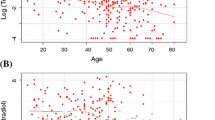Abstract
Osteoporosis is a growing health problem in women and in men. This cross-sectional study examined the association of anthropometric, lifestyle, and hormonal factors with bone mineral density (BMD) in 152 healthy Korean middle-aged men. Smoking habits and alcohol consumption were assessed by interview. Serum testosterone and insulin-like growth factor-I (IGF-I) levels were measured by radioimmunoassay, and serum growth hormone (GH) levels were measured by immunoradiometric assay. GH stimulation tests were performed after the ingestion of 500 mg of L-dopa. BMD was measured at the lumbar spine and at the femoral neck by dual-energy X-ray absorptiometry. Of the middle-aged men, 3.9% were osteoporotic and 28.3% were osteopenic at the lumbar spine site, and 5.9% were osteoporotic and 45.4% were osteopenic at the femoral neck site. Lumbar spine BMD correlated significantly with body mass index (BMI), and femoral neck BMD correlated significantly with age, BMI, and serum IGF-I levels. The lowest quartile group for serum IGF-I levels showed the lowest femoral neck BMD. Osteoporotic men by lumbar spine BMD showed significant differences from the normal BMD group in terms of BMI and smoking habits. Also, osteoporotic men by femoral neck BMD were significantly different for mean age, BMI, and serum IGF-I levels compared with the normal BMD group. On multiple regression analysis, BMI was found to be the only independent predictor of lumbar spine BMD, whereas both BMI and serum IGF-I levels were found to be the independent predictors of femoral neck BMD. Overall, 28.3%–45.4% of middle-aged Korean men were osteopenic. We suggest that higher age, a lower BMI, current smoking history, and lower serum IGF-I levels are risk factors for lower BMD in middle-aged Korean men; however, serum testosterone levels and GH secretory capacity were not found to be correlated with BMD.
Similar content being viewed by others
Author information
Authors and Affiliations
Corresponding author
About this article
Cite this article
Rhee, EJ., Oh, KW., Lee, WY. et al. Age, body mass index, current smoking history, and serum insulin-like growth factor-I levels associated with bone mineral density in middle-aged Korean men. J Bone Miner Metab 22, 392–398 (2004). https://doi.org/10.1007/s00774-003-0500-0
Received:
Accepted:
Issue Date:
DOI: https://doi.org/10.1007/s00774-003-0500-0




